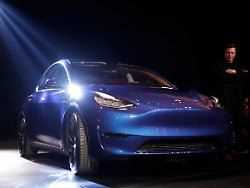Tuesday, July 27, 2021
“Big compliments to Elon Musk”
Where Tesla gets the curve – and where it doesn’t
By Diana Dittmer
Tesla boss Musk earns real money for the first time selling cars. Auto expert Dudenhöffer particularly praises savings through new batteries. After CO2 certificates and Bitcoin, a new subscriber line of business is causing fantasies. But the persecutors persist.
With spectacular announcements and expensive new developments, the electric car pioneer Tesla has had no problem in the past pushing the traditional carmakers forward. The income, however, especially with what he earned money, left to be desired. That changed in the second quarter, Tesla is finally profitable in its core business.
With 200,000 cars, CEO Elon Musk delivered more cars than ever before. Experts’ expectations were exceeded thanks to higher prices and savings. Observers are full of praise: Tesla impresses because “the majority of its revenue comes from vehicle sales,” says Jesse Cohen, senior analyst at Investing.com. “It is no longer a small niche provider, it is a large company,” commented Jürgen Piper from Bankhaus Metzler at ntv.
Savings from new batteries
Auto expert Ferdinand Dudenhöffer locates the first billion dollar profit primarily in China. “You have to give Elon Musk a big compliment,” says the head of the Duisburg Center for Automotive ntv.de. With the use of iron-phosphate battery cells from the Chinese battery manufacturer CATL, Musk has succeeded in making the basic equipment of the Model 3, which is being built for the Chinese market, “the largest cost item, the battery, significantly more cost-effective”.
Tesla sales rose $ 1.6 billion to $ 10.2 billion from the previous quarter. At the same time, operating costs fell $ 49 million to $ 1.57 billion. “That is only possible with great innovation in the cost area,” said Dudenhöffer. As a result, Tesla remains the benchmark for classic car manufacturers for the most expensive component of the electric car.
Further savings potential is also emerging: “The use of the larger 4680 battery cell at Tesla will be exciting in the next few months,” predicts the auto expert. “From today’s perspective, it promises a further significant reduction in costs and an increase in the range of the vehicles.”
First profit without CO2 certificates
Tesla has taken a lot of criticism in the past because the company made its money with CO2 certificates or income from price gains on its Bitcoin stocks – and not with its hardware, the e-car. That too changed in the second quarter. Carbon credit earnings were down $ 164 million from the previous quarter. Still, Tesla is making a giant leap in overall profit.
Profits from Bitcoin holdings also had less of an impact this time. Because of exchange rate losses, Tesla even had to write off $ 23 million in the second quarter.
The e-car pioneer has also changed lanes on other issues: there has recently been movement in the much-criticized cost point of the driver assistance system. With a new subscription model you want to accommodate undecided customers, the bottom line is, according to Morgan Stanley, it is much more lucrative than the original model. The US investment bank is convinced that Tesla could end up making significantly more money selling software subscriptions than selling its vehicles.
Is the subscription model the future money machine?
The experts’ calculation is simple: subscribers pay US $ 199 per month for the full self-driving monthly subscription that has been introduced – which is significantly more than expected. The upfront price for the software is $ 10,000. Projected over a 15-year useful life for a Tesla vehicle, the one-time price means costs of US $ 56 per month. In the end, a subscription is three and a half times as expensive as the one-time purchase. Morgan Stanley senses a billion dollar business. The bank predicts that the current fleet will grow from 1.5 million vehicles to 35 to 40 million by the end of the decade – and subscription revenues will grow significantly.
The US newspaper “Barron’s” quotes the New Street Research analyst Pierre Ferragu in this context. He estimates that by 2030, Tesla will make around $ 7,000 in profits from sales of a car and nearly $ 23,000 from sales of subscriptions to the driving software.
Auto expert Dudenhöffer also thinks Tesla’s subscription model is “interesting”. However, it is not a unique selling point. “Everyone is working on that today, including the VW Group with its CARIAD company or Daimler, Geely, etc. Selling software temporarily, for example via subscription or OTA (Over The Air) will be the new business model. The question is how fast. ”
Tesla’s lead is shrinking
Frank Schwope from NordLB is not convinced by the Tesla subscription. He by no means believes that it could even be a “game changer”, as Morgan Stanley calculates it. “It’s not a self-driving car. Certainly, a lot of people are willing to shell out additional money for some features. However, Waymo and Cruise are likely to be significantly further than Tesla in terms of autonomous driving,” he tells ntv.de.
The pressure of the established automobile manufacturers on Tesla has increased enormously. Volkswagen and Daimler have recently “accelerated” their electric strategies significantly. As early as next year, Volkswagen could be on par with Tesla in terms of sales of electric cars, writes Schwope in a short study.
The lead of the electric car pioneer is therefore shrinking further. Ultimately, that is likely to be the reason why Morgan Stanley has maintained its target price of 900 US dollars despite the billion-dollar forecast. The successful second quarter figures do not encourage investors to buy either.
.
